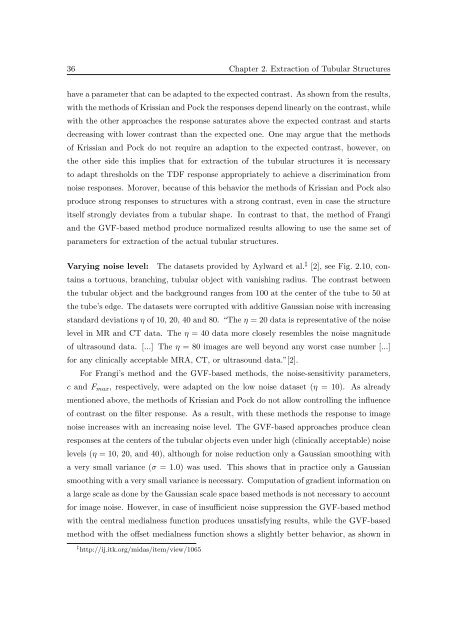Segmentation of 3D Tubular Tree Structures in Medical Images ...
Segmentation of 3D Tubular Tree Structures in Medical Images ...
Segmentation of 3D Tubular Tree Structures in Medical Images ...
You also want an ePaper? Increase the reach of your titles
YUMPU automatically turns print PDFs into web optimized ePapers that Google loves.
36 Chapter 2. Extraction <strong>of</strong> <strong>Tubular</strong> <strong>Structures</strong><br />
have a parameter that can be adapted to the expected contrast. As shown from the results,<br />
with the methods <strong>of</strong> Krissian and Pock the responses depend l<strong>in</strong>early on the contrast, while<br />
with the other approaches the response saturates above the expected contrast and starts<br />
decreas<strong>in</strong>g with lower contrast than the expected one. One may argue that the methods<br />
<strong>of</strong> Krissian and Pock do not require an adaption to the expected contrast, however, on<br />
the other side this implies that for extraction <strong>of</strong> the tubular structures it is necessary<br />
to adapt thresholds on the TDF response appropriately to achieve a discrim<strong>in</strong>ation from<br />
noise responses. Morover, because <strong>of</strong> this behavior the methods <strong>of</strong> Krissian and Pock also<br />
produce strong responses to structures with a strong contrast, even <strong>in</strong> case the structure<br />
itself strongly deviates from a tubular shape. In contrast to that, the method <strong>of</strong> Frangi<br />
and the GVF-based method produce normalized results allow<strong>in</strong>g to use the same set <strong>of</strong><br />
parameters for extraction <strong>of</strong> the actual tubular structures.<br />
Vary<strong>in</strong>g noise level: The datasets provided by Aylward et al. ‡ [2], see Fig. 2.10, conta<strong>in</strong>s<br />
a tortuous, branch<strong>in</strong>g, tubular object with vanish<strong>in</strong>g radius. The contrast between<br />
the tubular object and the background ranges from 100 at the center <strong>of</strong> the tube to 50 at<br />
the tube’s edge. The datasets were corrupted with additive Gaussian noise with <strong>in</strong>creas<strong>in</strong>g<br />
standard deviations η <strong>of</strong> 10, 20, 40 and 80. “The η = 20 data is representative <strong>of</strong> the noise<br />
level <strong>in</strong> MR and CT data. The η = 40 data more closely resembles the noise magnitude<br />
<strong>of</strong> ultrasound data. [...] The η = 80 images are well beyond any worst case number [...]<br />
for any cl<strong>in</strong>ically acceptable MRA, CT, or ultrasound data.”[2].<br />
For Frangi’s method and the GVF-based methods, the noise-sensitivity parameters,<br />
c and F max , respectively, were adapted on the low noise dataset (η = 10). As already<br />
mentioned above, the methods <strong>of</strong> Krissian and Pock do not allow controll<strong>in</strong>g the <strong>in</strong>fluence<br />
<strong>of</strong> contrast on the filter response. As a result, with these methods the response to image<br />
noise <strong>in</strong>creases with an <strong>in</strong>creas<strong>in</strong>g noise level. The GVF-based approaches produce clean<br />
responses at the centers <strong>of</strong> the tubular objects even under high (cl<strong>in</strong>ically acceptable) noise<br />
levels (η = 10, 20, and 40), although for noise reduction only a Gaussian smooth<strong>in</strong>g with<br />
a very small variance (σ = 1.0) was used. This shows that <strong>in</strong> practice only a Gaussian<br />
smooth<strong>in</strong>g with a very small variance is necessary. Computation <strong>of</strong> gradient <strong>in</strong>formation on<br />
a large scale as done by the Gaussian scale space based methods is not necessary to account<br />
for image noise. However, <strong>in</strong> case <strong>of</strong> <strong>in</strong>sufficient noise suppression the GVF-based method<br />
with the central medialness function produces unsatisfy<strong>in</strong>g results, while the GVF-based<br />
method with the <strong>of</strong>fset medialness function shows a slightly better behavior, as shown <strong>in</strong><br />
‡ http://ij.itk.org/midas/item/view/1065















